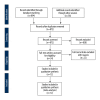Utility of MRI Diffusion Tensor Imaging in Carpal Tunnel Syndrome: A Meta-Analysis
- PMID: 26942911
- PMCID: PMC4784544
- DOI: 10.12659/msm.895758
Utility of MRI Diffusion Tensor Imaging in Carpal Tunnel Syndrome: A Meta-Analysis
Abstract
BACKGROUND After successful utilization of diffusion tensor imaging (DTI) in detecting brain pathologies, it is now being examined for use in the detection of peripheral neuropathies. The aim of this meta-analysis was to evaluate the diagnostic potentials of DTI in carpal tunnel syndrome (CTS). MATERIAL AND METHODS The literature search was performed in multiple electronic databases using a keyword search and final selection of the studies was based on predetermined inclusion and exclusion criteria. We performed a meta-analyses of mean differences in fractional anisotropy (FA) and apparent diffusion coefficient (ADC) between CTS patient and healthy subjects. Publication bias detection was done with Begg's test and sensitivity analyses were performed to explore the source/s of higher heterogeneity and the authenticity of results. RESULTS FA was significantly lower in CTS patients in comparison with healthy subjects (mean and the difference [95% confidence interval] was -0.06 [-0.10, -0.02] (p=0.003). The ADC was significantly higher in CTS patients (mean difference [95% CI] was 0.10 [0.02, 0.18], p=0.02). Overall sensitivity of FA-based diagnosis was 82.82%, with 77.83% specificity. CONCLUSIONS DTI can be a valuable tool in diagnosing CTS.
Figures




References
-
- Basser PJ, Jones DK. Diffusion-tensor MRI: theory, experimental design and data analysis – A technical review. NMR Biomed. 2002;5:456–67. - PubMed
-
- Beaulieu C. The basis of anisotropic water diffusion in the nervous system – A technical review. NMR Biomed. 2002;15:435–55. - PubMed
-
- Basser PJ. Inferring microstructural features and the physiological state of tissues from diffusion-weighted images. NMR Biomed. 1995;7–8:333–44. - PubMed
Publication types
MeSH terms
LinkOut - more resources
Full Text Sources
Medical
Research Materials

